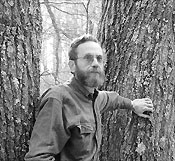|
Mountain People Stand Up to Ravages of Industry
 By Jenny Coyle By Jenny Coyle
Say it wrong enough times in one conversation and Dave Muhly will threaten to "throw an apple atcha," offering a handy reminder of how to pronounce the name of the mountainous region that stretches from Maine to Georgia.
Geologists say the Appalachian range is one of the oldest mountain ranges in the world - more ancient than the Rockies, the Sierra Nevada and even the Himalayas. Once as lofty as others in North America, the peaks have eroded over millions of years while still harboring a world-renown diversity of plant and animal species, not to mention a hardy population of human beings.
 But a century of abuse by extractive industries has brought about a new kind of erosion: Corporations raze entire mountaintops and poison soil, air and water, driving plant and animal species to extinction and destroying the Appalachian folks' way of life. But a century of abuse by extractive industries has brought about a new kind of erosion: Corporations raze entire mountaintops and poison soil, air and water, driving plant and animal species to extinction and destroying the Appalachian folks' way of life.
The human inhabitants have always banded together, neighbor with neighbor, to shoulder the challenges of nature, whether it be snowstorms or floods. In much the same way, the Sierra Club chapters in the Southern Appalachian Highlands Ecoregion (SAHE) are taking a cooperative approach to countering the assaults of industry.
The Southern Appalachians are among the most biologically diverse temperate forests in the world. The galax, above, is a native plant found throughout the mountain range. The headwaters for some major river systems are also found here.
Within the region there are seven states coordinating their efforts in an End Commercial Logging on Public Lands Campaign. Six have come together for an environmental justice project. Four have pooled financial resources in a lawsuit against two polluting power plants. Still others are fighting the ruins of coal mining.
"We're creating a synergy here," said Malkia M'buzi Moore, head of the Sierra Club's Appalachian Region field office in Georgia. "United we can be a real force as we push for change."
 Muhly, the Club's forest organizer for the ecoregion, maintains a small office in Bland County, Va., population 7,000, but he lives up a hollow called Dismal Creek. That's one drainage over from Nobusiness Creek. Muhly, the Club's forest organizer for the ecoregion, maintains a small office in Bland County, Va., population 7,000, but he lives up a hollow called Dismal Creek. That's one drainage over from Nobusiness Creek.
He tells the story of a friend who moved from the Appalachians to go to college in California. "But I'll come back home to Appalachia," she told him. "These mountains in California are stark and beautiful, but the Appalachians caress you. I'll always come home."
"The mountains bind us to each other," said Muhly, "and we are proud to be mountain people."
From Logging to Restoration
Dave Muhly will tell you that cutting trees is "more than just a way to put beans on the table" for logging families in the Appalachian mountains - it's a culture, a way of life.
"We quote figures about how much more money and jobs there would be if we stopping logging and depended instead on recreation and tourism," he said. "This is true, and it's an important piece of our public education work, but we may not fully understand that in many rural communities we're asking families to give up their lifestyles, their sense of identity, generations of a way of life."
And yet, Muhly hopes these families will someday add their voices to the public demand to end commercial logging on national forests. The key to bringing them in, he said, is to talk face to face about what he considers an under-sold part of the Club's End Commercial Logging on Federal Lands Campaign: restoration.
"We need to explain what it means, what stream restoration involves, what road obliteration is. Certainly someone who loves the smell of diesel can get his bulldozer behind destroying a road as much as building one," he said. "There will still be work to do in the woods. They don't have to be tour guides."
Muhly is part of the national ECL Campaign in the Southern Appalachians, and to help educate residents about the program, he's put together a slide show called "Appalachian Treasures at the Crossroads," which he presents to Sierra Club groups as well as Rotary Clubs and other civic and conservation groups.
"There's resistance from federal and state agencies who have a say in the plan, and from the logging industry," he said. "So we're working to build a groundswell of support from the public."
The program has also set a goal to get an ECL citizen's alternative included in the forest plans currently under way in national forests in Georgia, Alabama, South Carolina, Virginia and Tennessee. North Carolina and West Virginia are also part of the ECL program.
There are more ways to silence the chainsaws that slice their way through public forests that drape the Appalachian Range.
 Gordon Smith is the North Carolina Chapter's forest issues chair and a delegate to the SAHE Task Force. He's working with groups that inventory old growth and lobby members of Congress to co-sponsor ECL legislation. Gordon Smith is the North Carolina Chapter's forest issues chair and a delegate to the SAHE Task Force. He's working with groups that inventory old growth and lobby members of Congress to co-sponsor ECL legislation.
"We also host Sierra Club outings to places we want to see protected," Smith said. "If we can get people out to these forests, we build a constituency for them."
Taking Dirty Air to Court
Roger Jenkins was one of the first "900 milers." That's the elite group of people who can say they've hiked all 900 miles of trails in the Great Smoky Mountains National Park.
But in the 25 years he's lived in eastern Tennessee, he has watched the degradation of the Smoky's high-elevation forests and waterways due to air pollution and acid rain. Big contributors to the problem are coal-fired power plants operated by the Tennessee Valley Authority (TVA), which is responsible for 75 percent of sulfur dioxide emissions in the region, and 33 percent of nitrogen oxide - the components of smog and acid rain.
 |
Coal-fired power plants operated by the Tennessee Valley Authority, like the Colbert plant in Alabama, are the main sources of smog and acid rain in the region. The pollution causes asthma, heart problems, bronchitis and other respiratory problems in humans. It also kills trees and acidifies streams. The Sierra Club has sued the power company to come into compliance with the Clean Air Act. |
Jenkins is among those who submitted affidavits for a lawsuit filed by the Sierra Club and the National Parks Conservation Association in January against two of TVA's dirtiest plants - Bull Run in Tennessee and its Colbert plant in Alabama. The company has never obtained permits required by the Clean Air Act, nor installed available control technology when major modifications were performed the plants. That's because the company claims it has been doing "routine maintenance," not making changes that would trigger the new standards.
Muhly said modifications to the Bull Run plant cost $8.3 million in 1988 and were designed to extend the life of the boilers at least another 20 years. In 1982, the $50 million overhaul of the Colbert plant was the largest such project ever undertaken by TVA. In both cases, pollution emissions increased after the changes.
"If you compare it to an automobile, 'routine maintenance' means they can change the oil and put new brake pads on," said Muhly. "But these guys are basically overhauling the engine and transmission, and dropping a whole new body on the chassis."
Pitching in for lawsuit costs were Club chapters in Alabama, Tennessee, and Virginia, and the SAHE.
"It's time for TVA to clean up," said Jenkins.
Listening, Learning to Help
While exquisite in its beauty and biodiversity, the Central Appalachian region suffers from a century of coal mining, whether from tunneling underground or lopping off entire mountaintops. In Pennsylvania, Ohio, Kentucky, Virginia, West Virginia and Tennessee there are abandoned settlement ponds full of toxic chemicals, soil saturated with dioxin. The region's poverty rate is 49 percent.
 It was Larry Wilson who suggested the Sierra Club should include the area in its Environmental Justice Program. Wilson and his wife Sheila are the two full-time (unpaid) staff members at Appalachian Focus, a Kentucky- based non-profit organization working to improve life for residents of Central Appalachian coal country. It was Larry Wilson who suggested the Sierra Club should include the area in its Environmental Justice Program. Wilson and his wife Sheila are the two full-time (unpaid) staff members at Appalachian Focus, a Kentucky- based non-profit organization working to improve life for residents of Central Appalachian coal country.
"So we discussed it, and someone said, 'Is this something we can do?' And I said, 'Hell yes it is!' So we launched the Appalachian EJ Listening Project,'" recalled Jordan Holtam, a lead Sierra Club volunteer on the project. The Club will work in partnership with Appalachian Focus to help coal-mining communities impacted by mining.
What do the communities need? Toxic waste cleanups? Water quality tests? Even Wilson, a fifth-generation resident on a piece of land in the heart of the Appalachians, won't venture a guess. That's why it's a "listening project," he says.
The first step is to have Appalachia Focus volunteers from coal-mining communities talk to their peers, tell them the Sierra Club is willing to help, get a sense of high-priority needs - and determine whether the Club is welcome.
Wilson warned that it wouldn't be easy. Social workers and community organizers have come, built their credentials and left when the funding dried up. "We'll need to build trust in communities that don't like outsiders," he said. "They're besieged with problems - and besieged with people who want to capitalize on the problems. It's easy to talk the talk, but another thing entirely to walk the walk."
"Tough as it sounds, I'm drawn to it," said Holtam, who spent 37 years in Africa working in community and agricultural development and is the North Carolina Chapter delegate to the SAHE Task Force. "I'm not a detail guy, and I'm not great at organizing rallies, but this project was like finding a lost glove in a woodpile."
Holtam and Wilson are hopeful the Sierra Club and Appalachian Focus can succeed where others failed - if the communities want them to.
"I'm nervous," said Wilson, "but optimistic."
No Justice in the Coalfields
In coal country, it's possible for a couple to own their property while a mining company owns the mineral rights 400 to 600 feet under the house.
 Longwall mining, which takes advantage of that set-up, is a form of coal mining gaining popularity in Pennsylvania, Ohio and West Virginia - and wreaking havoc on communities and the environment. A machine bores underground, and a cutting head moves back and forth across a panel of coal about 1,000 feet wide and up to 10,000 feet long. Coal is carried out by a conveyor belt and hydraulic roof supports are advanced as the seam is cut. Meanwhile on the surface, the land subsides three to four feet. Longwall mining, which takes advantage of that set-up, is a form of coal mining gaining popularity in Pennsylvania, Ohio and West Virginia - and wreaking havoc on communities and the environment. A machine bores underground, and a cutting head moves back and forth across a panel of coal about 1,000 feet wide and up to 10,000 feet long. Coal is carried out by a conveyor belt and hydraulic roof supports are advanced as the seam is cut. Meanwhile on the surface, the land subsides three to four feet.
Wyona Coleman of the Club's Pennsylvania Chapter, is chair of the Tri-State Citizens Mining Network, and has seen the results.
"The damage to houses can be extensive because the land subsides unevenly and twists the foundation," she said. "Longwalling can destroy your home, your barn, your well and springs, and your livestock's water supplies."
The company must pay for home repairs, or replace a damaged water system, although in the latter case they may just bring in a water buffalo - a plastic bladder the size of a truck - and keep it filled.
"When streambeds are undermined," said Coleman, "there's uneven subsidence, which breaks a continuously flowing stream into sediment-laden pools incapable of supporting aquatic life."
Activists have been fighting to get the Environmental Protection Agency to study the effect of longwall mining on streams, and they've pushed for more restrictive laws. In the meantime, the companies go where they want.
"Property rights and environmental protection play second fiddle to mining interests," said Coleman. "There's no environmental justice in the coalfields."
Up to Top
|